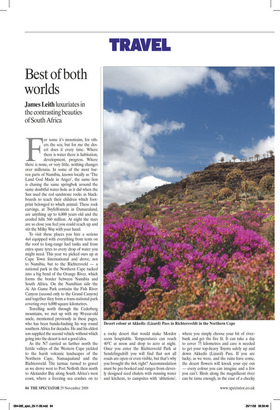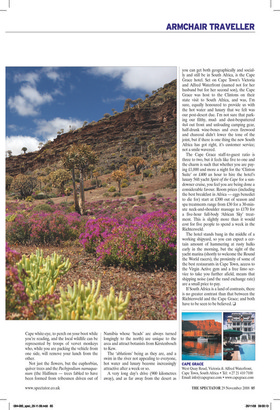Best of both worlds
James Leith luxuriates in the contrasting beauties of South Africa For some it’s mountains, for others the sea; but for me the desert does it every time. Where there is water there is habitation, development, progress. Where there is none, or very little, nothing changes over millennia. In some of the most barren parts of Namibia, known locally as ‘The Land God Made in Anger’, the same lion is chasing the same springbok around the same doubtful water-hole as it did when the San used the red sandstone rocks as blackboards to teach their children which footprint belonged to which animal. These rock carvings, at Twyfelfontein in Damaraland, are anything up to 6,000 years old and the eroded hills 560 million. At night the stars are so close you feel you could reach up and stir the Milky Way with your hand.
To visit these places you hire a serious 4x4 equipped with everything from tents on the roof to long-range fuel tanks and from extra spare tyres to every drop of water you might need. This year we picked ours up at Cape Town International and drove, not to Namibia, but to the Richtersveld — a national park in the Northern Cape tucked into a big bend of the Orange River, which forms the border between Namibia and South Africa. On the Namibian side the Ai Ais Game Park contains the Fish River Canyon (second only to the Grand Canyon) and together they form a trans-national park covering over 6,000 square kilometres.
Travelling north through the Cederberg mountains, we met up with my 90-year-old uncle, mentioned previously in these pages, who has been bundu-bashing his way round southern Africa for decades. He and his eldest son supplied the second vehicle without which going into the desert is not a good idea.
As the N7 carried us farther north the fertile valleys of the Western Cape yielded to the harsh volcanic landscapes of the Northern Cape, Namaqualand and the Richtersveld. The tarmac turned to gravel as we drove west to Port Nolloth then north to Alexander Bay along South Africa’s west coast, where a freezing sea crashes on to a rocky desert that would make Mordor seem hospitable. Temperatures can reach 40°C at noon and drop to zero at night. Once you enter the Richtersveld Park at Sendelingsdrift you will find that not all roads are open or even visible, but that’s why you brought the 4x4, right? Accommodation must be pre-booked and ranges from cleverly designed reed chalets with running water and kitchens, to campsites with ‘ablutions’, where you simply choose your bit of riverbank and get the fire lit. It can take a day to cover 75 kilometres and care is needed to get your top-heavy Toyota safely up and down Akkedis (Lizard) Pass. If you are lucky, as we were, and the rains have come, the desert flowers will knock your eye out — every colour you can imagine and a few you can’t. Birds along the magnificent river can be tame enough, in the case of a cheeky Cape white-eye, to perch on your boot while you’re reading, and the local wildlife can be represented by troops of vervet monkeys who, while you are packing the vehicle from one side, will remove your lunch from the other.
Not just the flowers, but the euphorbias, quiver trees and the Pachypodium namaquanum (the Halfmen — trees fabled to have been formed from tribesmen driven out of Namibia whose ‘heads’ are always turned longingly to the north) are unique to the area and attract botanists from Kirstenbosch to Kew.
The ‘ablutions’ being as they are, and a swim in the river not appealing to everyone, hot water and luxury become increasingly attractive after a week or so.
A very long day’s drive (900 kilometres away), and as far away from the desert as you can get both geographically and socially and still be in South Africa, is the Cape Grace hotel. Set on Cape Town’s Victoria and Alfred Waterfront (named not for her husband but for her second son), the Cape Grace was host to the Clintons on their state visit to South Africa, and was, I’m sure, equally honoured to provide us with the hot water and luxury that we felt was our post-desert due. I’m not sure that parking our filthy, mudand dust-bespattered 4x4 out front and unloading camping gear, half-drunk wine-boxes and even firewood and charcoal didn’t lower the tone of the joint, but if there is one thing the new South Africa has got right, it’s customer service; not a smile wavered.
The Cape Grace staff-to-guest ratio is three to two, but it feels like five to one and the charm is such that whether you are paying £1,000 and more a night for the ‘Clinton Suite’ or £400 an hour to hire the hotel’s luxury 56ft yacht Spirit of the Cape for a sundowner cruise, you feel you are being done a considerable favour. Room prices (including the best breakfast in Africa — eggs benedict to die for) start at £300 out of season and spa treatments range from £30 for a 30-minute neck-and-shoulder massage to £170 for a five-hour full-body ‘African Sky’ treatment. This is slightly more than it would cost for five people to spend a week in the Richtersveld.
The hotel stands bang in the middle of a working shipyard, so you can expect a certain amount of hammering at rusty hulks early in the morning, but the sight of the yacht marina (shortly to welcome the Round the World racers), the proximity of some of the best restaurants in Cape Town, access to the Virgin Active gym and a free limo service to take you further afield, means that shipping noise (and the rand exchange rate) are a small price to pay.
If South Africa is a land of contrasts, there is no greater contrast than that between the Richtersveld and the Cape Grace; and both have to be seen to be believed. ❑



































































































 Previous page
Previous page